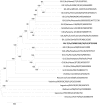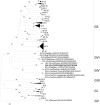Discovery and genomic characterization of noroviruses from a gastroenteritis outbreak in domestic cats in the US
- PMID: 22389721
- PMCID: PMC3289677
- DOI: 10.1371/journal.pone.0032739
Discovery and genomic characterization of noroviruses from a gastroenteritis outbreak in domestic cats in the US
Abstract
Norovirus (NoV) RNA was detected in the stools of 6 out 14 (42.8%) 8-12-week-old cats with enteritis from a feline shelter, in New York State. Upon sequence analysis of the complete capsid, the six NoVs were found to be identical, suggesting the spread of a unique NoV strain in the shelter. The full-length genomic sequence (7839 nt) of one feline NoV, CU081210E/2010/US, was determined. In the capsid protein VP1 region, the virus displayed the highest amino acid identity to animal genogroup IV genotype 2 (GIV.2) NoVs: lion/Pistoia-387/06/IT (97.9%) and dog/Bari-170/07/IT (90.4%). These findings document the discovery of a novel feline calicivirus, different from vesiviruses, and extend the spectrum of NoV host range. Epidemiological studies using feline NoV-specific diagnostic tools and experimental infection of cats are required to understand whether NoVs have a pathogenic role in this species.
Conflict of interest statement
Figures


References
-
- Green KY. Caliciviridae: the noroviruses. In: Knipe DM, Howley PM, editors. Fields Virology. Philadelphia: Wolters Kluwer Health/Lippincott Williams and Wilkins; 2007. pp. 949–979.
-
- Zheng D-P, Ando T, Fankhauser RL, Beard RS, Glass RI, et al. Norovirus classification and proposed strain nomenclature. Virology. 2006;346(2):312–323. - PubMed
-
- Siebenga JJ, Vennema H, Zheng D-P, Vinjé J, Lee BE, et al. Norovirus illness is a global problem: emergence and spread of norovirus GII.4 variants, 2001–2007. J Infect Dis. 2009;200(5):802–812. - PubMed
Publication types
MeSH terms
LinkOut - more resources
Full Text Sources
Medical
Research Materials
Miscellaneous

